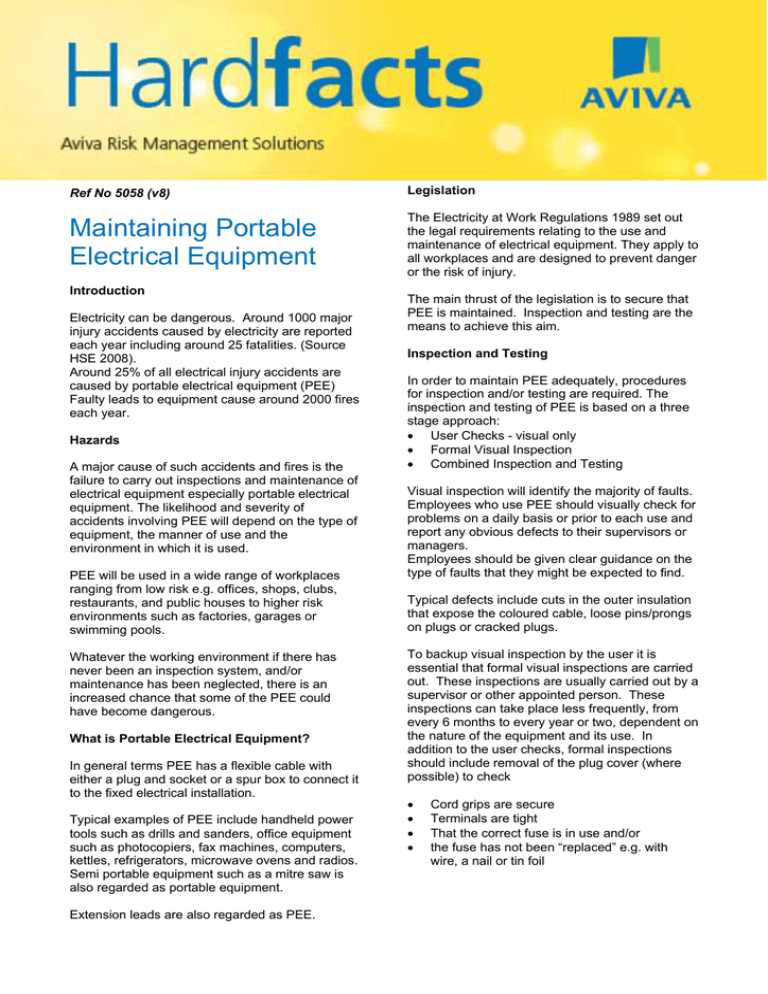
Ref No 5058 (v8)
Legislation
Maintaining Portable
Electrical Equipment
The Electricity at Work Regulations 1989 set out
the legal requirements relating to the use and
maintenance of electrical equipment. They apply to
all workplaces and are designed to prevent danger
or the risk of injury.
Introduction
Electricity can be dangerous. Around 1000 major
injury accidents caused by electricity are reported
each year including around 25 fatalities. (Source
HSE 2008).
Around 25% of all electrical injury accidents are
caused by portable electrical equipment (PEE)
Faulty leads to equipment cause around 2000 fires
each year.
Hazards
A major cause of such accidents and fires is the
failure to carry out inspections and maintenance of
electrical equipment especially portable electrical
equipment. The likelihood and severity of
accidents involving PEE will depend on the type of
equipment, the manner of use and the
environment in which it is used.
PEE will be used in a wide range of workplaces
ranging from low risk e.g. offices, shops, clubs,
restaurants, and public houses to higher risk
environments such as factories, garages or
swimming pools.
Whatever the working environment if there has
never been an inspection system, and/or
maintenance has been neglected, there is an
increased chance that some of the PEE could
have become dangerous.
What is Portable Electrical Equipment?
In general terms PEE has a flexible cable with
either a plug and socket or a spur box to connect it
to the fixed electrical installation.
Typical examples of PEE include handheld power
tools such as drills and sanders, office equipment
such as photocopiers, fax machines, computers,
kettles, refrigerators, microwave ovens and radios.
Semi portable equipment such as a mitre saw is
also regarded as portable equipment.
Extension leads are also regarded as PEE.
The main thrust of the legislation is to secure that
PEE is maintained. Inspection and testing are the
means to achieve this aim.
Inspection and Testing
In order to maintain PEE adequately, procedures
for inspection and/or testing are required. The
inspection and testing of PEE is based on a three
stage approach:
• User Checks - visual only
• Formal Visual Inspection
• Combined Inspection and Testing
Visual inspection will identify the majority of faults.
Employees who use PEE should visually check for
problems on a daily basis or prior to each use and
report any obvious defects to their supervisors or
managers.
Employees should be given clear guidance on the
type of faults that they might be expected to find.
Typical defects include cuts in the outer insulation
that expose the coloured cable, loose pins/prongs
on plugs or cracked plugs.
To backup visual inspection by the user it is
essential that formal visual inspections are carried
out. These inspections are usually carried out by a
supervisor or other appointed person. These
inspections can take place less frequently, from
every 6 months to every year or two, dependent on
the nature of the equipment and its use. In
addition to the user checks, formal inspections
should include removal of the plug cover (where
possible) to check
•
•
•
•
Cord grips are secure
Terminals are tight
That the correct fuse is in use and/or
the fuse has not been “replaced” e.g. with
wire, a nail or tin foil
Since not all faults can be detected by visual
inspection, PEE should be subjected to combined
inspection and electrical test using Portable
Appliance Test Equipment operated by a
competent, electrically qualified person.
These need to be carried out routinely, say every
few years. The precise frequency will be
determined by risk assessment, involving a
consideration of use, environment etc.
This does not mean that all PEE requires an
electrical test by a qualified electrician. Most
simple equipment will only require a visual
inspection, which can be carried out by anyone
who has been properly trained.
But where there is reason to suspect that the PEE
may be faulty, damaged or contaminated, then
only competent electrically qualified persons
should carry out testing, inspection or repairs.
If employees bring equipment to work and plug it
into your system it becomes your responsibility
and should be included in your inspection
schedule. Typical examples include kettles and
radios used in the canteen.
Faults to look for
The most important maintenance precaution is the
regular visual inspection carried out by the user.
Around 95% of faults or damage can be found by
looking.
Some faults to look for include:
• Damage to the flexible cable. e.g. cuts,
abrasions, cable trapped under furniture etc.
• Damage to the plug. e.g. cracked case or bent
pins.
• Illegal joints in the cable. e.g. taped joint or
‘chocolate block’ connectors.
• Equipment being used in unsuitable conditions,
e.g., wet or dusty.
• Signs of over heating e.g. burn marks or stains.
• Provide information and training for all users to
help them carry out user checks.
• Decide on appropriate frequency of formal
visual inspections.
• Set up a formal visual inspection system and
appoint and train competent persons to carry
out such inspections.
• Appoint a competent, electrically qualified
person to carry out Portable Appliance Testing
and any required electrical repairs.
• Review records of test results and monitor to
ensure that remedial repairs are carried out and
review frequency of visual inspections.
References
• The Memorandum of Guidance on Electricity at
Work Regulations 1989 (ACOP) Ref. HS(R) 25.
• Maintaining portable and transportable
electrical equipment Ref. HSG107
HSE Books
• The safe use of portable electrical apparatus.
Ref. HSE Guidance Note PM32, HSE Books
1990.
Free downloads from the HSE website.
Electrical Safety and you: INDG231
http://www.hse.gov.uk/pubns/indg231.pdf
Maintaining portable electrical equipment in offices
and other low risk environments: IND(G)236L
http://www.hse.gov.uk/pubns/indg236.pdf
HSE Electricity “microsite”
http://www.hse.gov.uk/electricity/index.htm
Free Leaflets on Electrical Safety
http://www.hse.gov.uk/pubns/elecindx.htm
Ref No 5058 (v8)
All employees should be made aware that they
must stop using any equipment that is found to be
faulty or defective and report faults/defects to their
supervisor.
Key Action Steps
• Identify all PEE and create a list/register to
ensure that items are not missed at the next
inspection.
• Decide what to do about PEE brought in by
employees (either ban its use or include on
your list for inspections.)
Aviva Risk Management Solutions
operate a Risk Helpline during normal
business hours for the cost of a local
telephone call. The telephone number is:
0845 366 66 66
www.aviva.co.uk/risksolutions
Hardfacts information sheets are designed to give general information on risk management topics. Readers should take specific advice when dealing with particular situations.
Aviva Risk Management Solutions accepts no responsibility for action taken as a result of information contained in this publication. The information in Hardfacts is correct at the
date of going to press. Printed and published by Aviva Risk Management Solutions, Friars Gate, Stratford Road, Solihull, West Midlands B90 4BN.
Telephone 0845 3016030 Fax 08000 687288 Sales Hotline 0500 55 99 77 e-mail: riskadvice@aviva.co.uk website: www.aviva.co.uk/risksolutions.
© Copyright, all rights reserved. Registered in England No. 2584450 Registered Office 8 Surrey Street Norwich NR1 3NG


